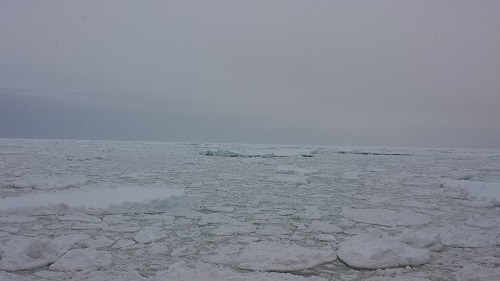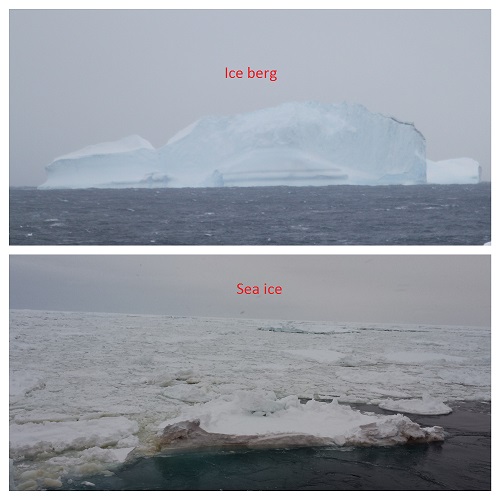Happy Easter
Did you know the Easter Bunny visits Antarctica?
 Did you know the Easter Bunny visits Antarctica? I found this on my cabin door Easter morning.
Did you know the Easter Bunny visits Antarctica? I found this on my cabin door Easter morning.
First Sea Ice
We’re in the ice! We saw our first sea ice about 3pm on April 4th our
time, just a few hours after I submitted yesterday’s blog.
Congratulations to Diana Rankin, who had the closest guess!
 Dominique Richardson with (some of the) first sea ice spooted on the expedition.
Dominique Richardson with (some of the) first sea ice spooted on the expedition.
We actually saw icebergs first, before getting to the sea ice. After seeing the first few bits of sea ice it wasn't long until we were surrounded.
 Sea ice on the southern ocean.
Sea ice on the southern ocean.
The water is nice and calm here and we’re moving pretty slowly to navigate through the ice. When we break through large pieces you can hear and feel the ice hit and scrape its way slowly along the sides of the ship.
 The bow camera showing the ship moving through sea ice.
The bow camera showing the ship moving through sea ice.
Let’s take a closer look at Sea Ice
 Questions submitted from Forrest, 2nd grade.
Questions submitted from Forrest, 2nd grade.
Forrest, 2nd grade, would like to take a closer look at sea ice. * How cold is sea ice compared to fresh water ice? * How cold is sea ice compared to the southern ocean?
Sea ice is frozen seawater that floats on the surface of the ocean, moving with currents and wind.
Because of winds, currents and temperature changes, sea ice is very dynamic and there are many different sea ice types. Here is a chart from the Tasmania Museum of Art that explains a just a few, basic types of sea ice.
 Sea ice formation explained by the Tasmanian Museum of Art.
Sea ice formation explained by the Tasmanian Museum of Art.
Sea ice forms when the ocean’s surface layer cools to the sea ice freezing point (the surrounding water is usually just above the freezing point, but can be warmer depending on the location). Since sea ice forms from ocean water instead of fresh water, it forms at a slightly colder temperature--29°F-- than freshwater ice—32°F. As sea ice forms a lot of salt is expelled out of the ice crystals, so sea ice is a little less salty than the surrounding ocean. However it is still saltier than fresh water ice, snow, and icebergs (which are made of fresh water).
Don’t confuse sea ice with icebergs! While sea ice is frozen ocean water, icebergs are large pieces of fresh water ice that have broken off glaciers or ice shelves and are floating free in the ocean.
 Don't confuse icebergs with sea ice. Icebergs are freshwater ice, while sea ice forms from salty ocean water.
Don't confuse icebergs with sea ice. Icebergs are freshwater ice, while sea ice forms from salty ocean water.
Some sea ice, permanently attached to the coast (called fast ice), can be up to 120 feet thick. Newly forming sea ice can be just a thin layer on the surface of the ocean. Most of the sea ice we will be traveling through is only 1-6 feet thick. By contrast, Antarctic icebergs are often more than 1,300 feet thick!
Why is sea ice growing?
So if Antarctic ice sheets are melting, why is Antarctic sea ice area at a high since 1978 (when satellite observations began)? By the way, if you didn’t know, Antarctic sea ice area is at a high. It seems like this would be at odds with what we think should happen in a warming climate. However, it is just what climate scientists expect as a result of the melting land ice and changing weather patterns caused by climate change.
We hear about how the Arctic (North Pole area) is rapidly losing the thick sea ice that has persisted over multiple years. We might expect the same in the Southern Ocean, but conditions at each of the poles are very different. The Arctic has no central continental ice, like what exists in Antarctica. In Antarctica, sea ice forms outward from the ice on the continent, growing and melting as the seasons change. The continental ice is fresh water ice that, as it melts, adds fresh water to the ocean. Increased fresh water input from mantling continental ice sheets, and increased precipitation, can make surface ocean water less salty, increasing the freezing point and making it easier for sea ice to form. With greater input of fresh water, sea ice can form at and survive relatively warmer temperatures.
Also, remember that sea ice is very dynamic and can be pushed about the ocean’s surface by winds. Strong katabatic winds also blow off the continent pushing sea ice outward. Increased winds—intensified by changing climate – push sea ice northward, increasing the area covered by the ice. As sea ice grows outward from the continent, it can cover a large area without necessarily being very thick—the volume of thin ice covering a wider area can be, overall, less ice than the volume of thick ice in a smaller area. So as climate change causes Antarctic ice sheets to melt, increased fresh water makes it easier for sea ice to form and stronger winds—also influenced by changing climate--pushing sea ice outward, increasing the sea ice cover in Antarctica.
Check out an interview about the increase in Antarctic sea ice with Dr. Guy Williams, one of the scientists on board:
Try it at home
Freezing point depression: why ocean water freezes at a colder temperature than fresh water. Get a bowl of ice water, measure the temperature. Add a cup of rock salt to the bowl of ice water and re-measure the temperature. What did adding salt do to the temperature of the ice water? Which was colder: the salt water or the fresh water?
Notes from the Scientists
Forrest’s questions have slightly more complicated answers that it would seem. Thankfully, I’m living and working with two sea ice experts while on the ship. So I deferred the more complicated components of the questions to them. Here is what Dr. Alex Fraser and Dr. Guy Williams (both of whom we’ll learn more soon) had to say regarding Forrest’s questions: Dr. Williams: If I may, I will probably re-phrase Forrest’s questions… How does sea ice differ from lake ice that forms over fresh water? The key difference is in the freezing temperature of sea ice vs. lake ice, or the temperature at which it changes from liquid to solid, as well as the way the water behaves as it approaches the freezing point. Fresh water freezes at 0 degree C. When most things cool, they shrink and their density increases. Denser things will sink below less dense things. For example – cold air sinks – just try opening the fridge with no shoes on to test that. As fresh water cools, it also does this, until it reaches 4 degree C, and something strange happens – it starts to expand as it cools to zero. Because it is expanding, the near-freezing fresh water wants to stay at the surface and continue losing heat until it freezes. When it freezes, the ice 'expands' and it floats on the surface, less dense than the water around it. If water behaved like other materials, i.e. continued to gain density, then ice would sink to the bottom of the lake and the lake would freeze from the bottom up.
Salt water is slightly different – for starters its freezing point is often less than 0. In the region of Antarctica we are going to it is between -1.8 to -1.9 degree C. Also, the change from contraction to expansion doesn't occur at 4 degrees – it continues to contract and so the surface of the ocean becomes mixed as near-freezing water at the surface 'sinks'. So you end up with a thicker layer of near-freezing water, compared to the lake, before freezing can occur and sea-ice forms. Of course, once it forms, it expands and stays at the surface. An interesting thing happens to the salt in the salt water as it freezes, but that will have to wait until next time! Hope that helps! We can leave 'brine-rejection' until it is time to talk about the polynyas and dense shelf water formation.
Dr. Fraser: Fresh water ice forms at 0 degrees Celsius. The temperature of sea ice formation varies with the salinity of the surface water, but generally forms at ~-1.8 degrees Celsius. As [Dr. Williams] said, sea ice is essentially frozen Southern Ocean. As you move south, the Southern Ocean cools until it reaches ~-1.8 [degrees Celsius] and then it freezes into sea ice. The top of the sea ice will be at the temperature of the atmosphere and the bottom of the sea ice will be at the temperature of the southern ocean beneath it. The warmest sea ice can possibly be is ~-1.8 [degrees Celsius]. There is no limit to how cold it can be. On the other hand, the warmest lake (fresh) ice can be is 0 C, and again there's no limit to how cold it can be. Generally the top of the sea or lake ice is the same temperature as the atmosphere (i.e., can be as cold as -30 C, or sometimes even colder) and the bottom is the same temperature as the ocean or lake it is in. This can create a temperature gradient across the ice. Depth of the ice and insulating factors, like snow, can change this temperature profile, but we can talk about that another time!


Comments